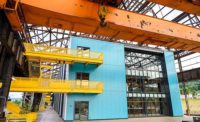Mississippi has a robust manufacturing sector that includes world-class companies such as Airbus Helicopters, GE Aviation, Ingalls Shipbuilding, Nissan, Northrop Grumman, Toyota and Viking Range. It’s also home to a world-class organization at the University of Mississippi.
The Haley Barbour Center for Manufacturing Excellence (CME) develops interdisciplinary educational opportunities and prepares students for careers in the world of modern manufacturing. It was created almost a decade ago when Toyota Motor Corp. decided to build an $800 million assembly plant in Blue Springs, MS. The 2-million-square-foot facility produces the Toyota Corolla sedan.
Although Toyota was a major contributor, the goal of the center is to represent manufacturing as a whole, not just from an automotive industry perspective. It provides real-world manufacturing experiences for students from three different schools on the Ole Miss campus.
“Toyota, previous university administration and former governor Haley Barbour shared a vision for a center that could develop young professionals within the fields of accountancy, business and engineering,” says Ryan Miller, CME’s associate director for external operations. “The [original goal of the center was to create] a cross-curricular environment in which students from these three fields would become ‘modern linguists.’
“Business and accountancy students would learn the language of engineering and engineering students would learn the language of business,” adds Miller. “Not only would manufacturing serve as the common language, but it would more accurately illustrate the opportunities that exist within industry. The CME is the culmination and realization of that vision.”
According to Miller, the center aims to replace antiquated mass-production ideas and concepts. “It was created to bridge the gap between the technical side of manufacturing and the business side,” he explains.
“We highlight career opportunities and new technologies that are changing the landscape of manufacturing in Mississippi and beyond,” Miller points out. “This involves taking students on tours of new manufacturing facilities and allowing manufacturers to make presentations to our students. We not only recruit students to the CME program, but to manufacturing as a whole.”
Students attend classes and conduct projects in the 47,000-square-foot CME facility, which features classrooms, labs and offices surrounding a 12,000-square-foot factory floor that includes a machine shop and an assembly line. The building accommodates 200 students and 16 employees, including four faculty members and four manufacturing technicians.
Ole Miss students are exposed to a variety of manufacturing processes and materials, including metal, plastic and wood fabrication. Rapid prototyping and composites are also included. The factory floor contains more than 60 machines that range from low-tech to cutting-edge.
“We possess the most sophisticated technologies, as well as some of the most rudimentary tools that are currently being used in the manufacturing arena,” says Miller. “This better prepares our students; they will be ready regardless of the level of technology they encounter in the workforce.”
The CME curriculum includes several courses that are based on the Toyota Production System. “[Some local] manufacturers have allowed classes to be taught within their respective facilities on topics such as process flow, standardized work and problem solving,” notes Miller. “The culmination of these classes often results in student suggestions for improvements that can be made to existing factory processes.”
Ole Miss students are also encouraged to participate in internships and cooperative education programs held at various manufacturers throughout the United States. “It is imperative that students be able to experience the real-world before they are thrust into it,” says Miller.







